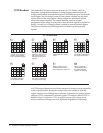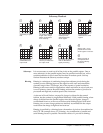
29
Chapter 3.
Advanced CCD Theory
Introduction
The charge-coupled device (CCD) is the imager of choice for use in quantitative
image acquisition systems. This chapter familiarizes you with CCDs and the
terminology used in describing them. It also discusses CCD performance
characteristics. If these are already familiar topics, you may still find this chapter
useful as a refresher or a reference.
Theory of
Operation
Most CCD imagers are made from silicon, because of its properties when
exposed to electromagnetic radiation in the visible spectrum.
In crystalline silicon, each atom is covalently bonded to its neighbors. Incident
photons that penetrate the lattice can break these bonds and generate electron-
hole pairs. Silicon becomes transparent at 1000–1100 nm and is opaque to light
at wavelengths shorter than 400 nm. The photon-produced electronic charge is
proportional to the incident light between these wavelength limits.
However, charge can be created by other energy sources. High-energy particles,
x-rays, and cosmic rays can break many thousands of bonds. Excessive exposure
can damage the crystal lattice.
Bonds can also be broken by thermal agitation. The rate of electron-hole pair
generation due to thermal energy is dependent on temperature and can be
reduced arbitrarily through cooling. The unwanted charge produced by thermal
agitation is called dark current, because it is produced in the absence of light.
Potential Wells
To measure the electronic charge produced by incident photons, there must be a
means of collecting the charge. The figure A Potential Well illustrates the
concept.
e
-
e
-
e
-
e
-
e
-
e
-
A Potential Well
Potential well
Silicon
Silicon dioxide
Polysilicon gate
Electrical connection
Incoming light
e
-
e
-


















